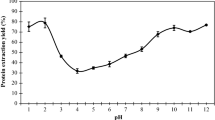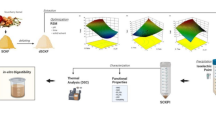Abstract
Stone fruit processing produces almost 20–30% of waste as seed kernels, which are rich source of valuable compounds like protein that can be used in various food formulations. So, the present study aimed to isolate protein from Meghalayan cherry kernel and study the effect of pH and dephenolization on biochemical, functional, and nutritional characteristics of protein isolate from the Meghalayan cherry kernel. Alkali (pH, 8.5–12.5) extraction and isoelectric precipitation were used to isolate kernel protein. Based on yield, purity, and color, pH 10.5 was most suitable for extracting protein. Dephenoized protein isolate (MCKPI-DP) showed higher protein content (88.81 ± 0.03%) as compared to natural protein isolate (MCKPI-N) (83.50 ± 0.01%). The significantly higher solubility, dispersibility, foaming properties, emulsion stability, and capacity were seen in dephenolized protein isolate, which increased with increased pH. Water binding capacity was higher for MCKPI-N than MCKPI-DP and further increased with an increase in pH. Meghalayan cherry kernel protein isolate was a rich source of essential amino acids except tryptophan required by infants and adults (FAO). MCKPI-DP showed better protein efficiency ratio (2.67 ± 0.03(PER1), 2.49 ± 0.02(PER2), 2.14 ± 0.04(PER3)), essential amino acid index (78.82 ± 0.85), EAA/TAA % (41.76 ± 0.01), nutritional index (65.82 ± 0.71), and biological value (74.22 ± 0.93) indicating the presence of good-quality proteins. As per the FAO standard, the amino acid score showed that all essential amino acids are in excess, thus helping fulfill essential amino acid requirements and being a good protein supplement source in food products. Moreover, this work helps better utilize agro-wastes as low-cost substrates for protein isolation.

Similar content being viewed by others
References
Henchion M, Hayes M, Mullen AM, Fenelon M, Tiwari B (2017) Future protein supply and demand: strategies and factors influencing a sustainable equilibrium. Foods 6(7):53
Deng Y, Huang L, Zhang C, Xie P, Cheng J, Wang X, Li S (2019) Physicochemical and functional properties of Chinese quince seed protein isolate. Food Chem 283:539–548
Kashyap P, Riar CS, Jindal N (2021) Optimization of ultrasound assisted extraction of polyphenols from Meghalayan cherry fruit (Prunus nepalensis) using response surface methodology (RSM) and artificial neural network (ANN) approach. J Food Meas Charact 15(1):119–133
Kashyap P, Riar CS, Jindal N (2022) Polyphenol bio-accessibility and antioxidant activity of in vitro digested ultrasound-assisted Meghalayan cherry (Prunus nepalensis) pomace extract. . Biomass Convers Biorefnery: 1–15
González-Pérez S, Vereijken JM (2007) Sunflower proteins: overview of their physicochemical, structural and functional properties. J Sci Food Agric 87(12):2173–2191
Sabir MA, Sosulski FW, Kernan JA (1974) Phenolic constituents in sunflower flour. J Sci Food Agric 22(4):572–574
Chavan UD, McKenzie DB, Shahidi F (2001) Functional properties of protein isolates from beach pea (Lathyrus maritimus L). Food Chem 74(2):177–187
Mir NA, Riar CS, Singh S (2019) Effect of pH and holding time on the characteristics of protein isolates from Chenopodium seeds and study of their amino acid profile and scoring. Food chem 272:165–173
Kaushik P, Dowling K, McKnight S, Barrow CJ, Wang B, Adhikari B (2016) Preparation, characterization and functional properties of flax seed protein isolate. Food Chem 197:212–220
AOAC (2006) Official methods of analysis, 18th edn. Association of Official Analytical Chemists, Arlington, VA
Kazemi M, Karim R, Mirhosseini H, Hamid AA (2016) Optimization of pulsed ultrasound-assisted technique for extraction of phenolics from pomegranate peel of Malas variety: punicalagin and hydroxybenzoic acids. Food Chem 206:156–166
Achouri A, Nail V, Boye JI (2012) Sesame protein isolate: fractionation, secondary structure and functional properties. Food Res Int 46:360–369
Lawal OS, Adebowale KO, Adebowale YA (2007) Functional properties of native and chemically modified protein concentrates from bambarra groundnut. Food Res Int 40:1003–1011
Malik MA, Saini CS (2017) Polyphenol removal from sunflower seed and kernel: effect on functional and rheological properties of protein isolates. Food Hydrocoll 63:705–715
Kullarni DK, Kullarni DN, Ingle UM (1991) Sorghum malt-based weaning food formulation: preparation, functional properties and nutritive value. Food Nutr Bull 13:324–327
Fekria AM, Isam AMA, Suha OA, Elfadil EB (2012) Nutritional and functional characterization of defatted seed cake flour of two Sudanese groundnut (Arachis hypogaea) cultivars. Int Food Res J 19:629–637
Alsmeyer RH, Cunningham AE, Happich ML (1974) Equations predicting PER from amino acid analysis. Food Technol 28:34–40
Oser BL (1959) An integrated essential amino acid index for predicting the biological value of proteins. In: Albanese AA (ed) Protein and amino acid nutrition. Academic Press, New York, pp 295–311
Ijarotimi OS (2012) Influence of germination and fermentation on chemical composition, protein quality and physical properties of wheat flour (Triticum aestivum). J Cereals OilSeeds 3:35–47
FAO (2013) Findings and recommendations of the 2011 FAO Expert Consultation on protein quality evaluation in human nutrition. In: Dietary Protein Quality Evaluation in Human Nutrition: Report of an FAO Expert Consultation. FAO Food and Nutrition Paper 92. Food and Agriculture Organization of the United Nations, Rome, Italy, chapter 4, 29
Subaşı BG, Casanova F, Capanoglu E, Ajalloueian F, Sloth JJ, Mohammadifar MA (2020) Protein extracts from de-oiled sunflower cake: structural, physico-chemical and functional properties after removal of phenolics. Food Biosci 38:100749
Gao Z, Shen P, Lan Y, Cui L, Ohm JB, Chen B, Rao J (2020) Effect of alkaline extraction pH on structure properties, solubility, and beany flavor of yellow pea protein isolate. Food Res Int 131:109045
Rui X, Boye JI, Ribereau S, Simpson BK, Prasher SO (2011) Comparative study of the composition and thermal properties of protein isolates prepared from nine Phaseolus vulgaris legume varieties. Food Res Int 44(8):2497–2504
Tang CH (2008) Thermal denaturation and gelation of vicilin-rich protein isolates from three Phaseolus legumes: a comparative study. LWT-Food Sci Technol 41(8):1380–1388
Salgado PR, Molina Ortiz SE, Petruccelli S, Mauri AN (2011) Sunflower protein concentrates and isolates prepared from oil cakes have high water solubility and antioxidant capacity. J Am Oil Chem Soc 88(3):351–360
Xu L, Diosady LL (2002) Removal of phenolic compounds in the production of high-quality canola protein isolates. Food Res Int 35(1):23–30
Damodaran S (1997) Food proteins: an overview. In: Damodaran S, Paraf A (eds) Food proteins and their applications. Marcel Dekker, New York, pp 1–24
Singh N, Kaur M, Sandhu KS (2005) Physicochemical and functional properties of freeze-dried and oven dried corn gluten meals. Dry Technol 23:975–988
Ali M, Homann T, Khalil M, Kruse HP, Rawel H (2013) Milk whey protein modification by coffee-specific phenolics: effect on structural and functional properties. J Agric Food Chem 61(28):6911–6920
Rohn S, Rawel HM, Röber M, Kroll J (2005) Reactions with phenolic substances can induce changes in some physico-chemical properties and activities of bromelain–the consequences for supplementary food products. Int J Food Sci Technol 40(7):771–782
Dickinson E (2010) Flocculation of protein-stabilized oil-in-water emulsions. Colloids Surf B: Biointerfaces 81(1):130–140
Xu D, Li C, Zhuo Z, Ye M, Fu B, Pu B (2020) Physicochemical and emulsifying properties of protein extracted from Zanthoxylum armatum seed kernel. Iranian J Sci Technol Trans A: Sci 44(1):65–73
Ulloa JA, Villalobos Barbosa MC, Resendiz Vazquez JA, Rosas Ulloa P, Ramírez Ramírez JC, Silva Carrillo Y, González Torres L (2017) Production, physico-chemical and functional characterization of a protein isolate from jackfruit (Artocarpus heterophyllus) seeds. CyTA-J Food 15(4):497–507
Sathe SK, Deshpande SS, Salunkhe DK (1982) Functional properties of lupin seed (Lupinus mutabilis) proteins and protein concentrates. J Food Sci 47(2):491–497
Çelik M, Güzel M, Yildirim M (2019) Effect of pH on protein extraction from sour cherry kernels and functional properties of resulting protein concentrate. J Food Sci Tech 56(6):3023–3032
Deng Q, Wang L, Wei F, Xie B, Huang F, Huang W, Shi J, Huang Q, Tian B, Xue S (2011) Functional properties of protein isolates, globulin and albumin extracted from Ginkgo biloba seeds. Food Chem 124:1458–1465
Fernández-Quintela A, Macarulla MT, Del Barrio AS, Martínez JA (1997) Composition and functional properties of protein isolates obtained from commercial legumes grown in northern Spain. Plant Foods Hum Nutr 51(4):331–341
Das D, Mir NA, Chandla NK, Singh S (2021) Combined effect of pH treatment and the extraction pH on the physicochemical, functional and rheological characteristics of amaranth (Amaranthus hypochondriacus) seed protein isolates. Food Chem 353:129466
Aluko RE, Yada RY (1995) Structure-function relationships of cowpea (Vigna unguiculata) globulin isolate: influence of pH and NaCl on physicochemical and functional properties. Food Chem 53(3):259–265
Kroll J, Rawel HM (2001) Reactions of plant phenols with myoglobin: influence of chemical structure of the phenolic compounds. J Food Sci 66(1):48–58
Pastor-Cavada E, Juan R, Pastor JE, Alaiz M, Vioque J (2010) Protein isolates from two Mediterranean legumes: Lathyrus clymenum and Lathyrus annuus Chemical composition functional properties and protein characterisation. Food Chem 122(3):533–538
Udenigwe CC, Aluko RE (2012) Food protein-derived bioactive peptides: production, processing, and potential health benefits. J Food Sci 77(1):R11–R24
Sibian MS, Saxena DC, Riar CS (2017) Effect of germination on chemical, functional and nutritional characteristics of wheat, brown rice and triticale: a comparative study. J Sci Food Agric 97(13):4643–4651
Anand TP, Chellaram C, Chandrika M, Rajamalar CG, Parveen AN, Shanthini F (2013) Nutritional studies on marine mollusk Pleuroploca trapezium (Gastropoda: Fasciolariidae) from Tuticorin coastal waters. J Chem Pharm Res 5(4):16–21
Salunkhe DK, Kadam SS (1989) Handbook of world food legumes: nutritional chemistry, processing technology, and utilization. CRC Press, Boca Raton, Flourida
Vinayashree S, Vasu P (2021) Biochemical, nutritional and functional properties of protein isolate and fractions from pumpkin (Cucurbita moschata var Kashi Harit) seeds. Food Chem 340:128177
Zeng HY, Cai LH, Cai XL, Wang YJ, Li YQ (2013) Amino acid profiles and quality from lotus seed proteins. J Sci Food Agric 93(5):1070–1075
Hoffman JR, Falvo MJ (2004) Protein–which is best? J Sports Sci Med 3(3):118
Babji AS, Fatimah S, Abolhassani Y, Ghassem M (2010) Nutritional quality and properties of protein and lipid in processed meat products–a perspective. Int Food Res J 17(1):35–44
Pietrysiak E, Smith DM, Smith BM, Ganjyal GM (2018) Enhanced functionality of pea-rice protein isolate blends through direct steam injection processing. Food Chem 243:338–344
Author information
Authors and Affiliations
Corresponding author
Ethics declarations
Conflict of interest
The authors declare no competing interests.
Additional information
Publisher's note
Springer Nature remains neutral with regard to jurisdictional claims in published maps and institutional affiliations.
Rights and permissions
About this article
Cite this article
Kashyap, P., Singh Riar, C. & Jindal, N. Effect of dephenolization and pH on functional properties, amino acid profile, and nutritional characteristics of protein isolate from Meghalayan cherry (Prunus nepalensis) kernel. Biomass Conv. Bioref. 14, 4883–4895 (2024). https://doi.org/10.1007/s13399-022-02740-6
Received:
Revised:
Accepted:
Published:
Issue Date:
DOI: https://doi.org/10.1007/s13399-022-02740-6




